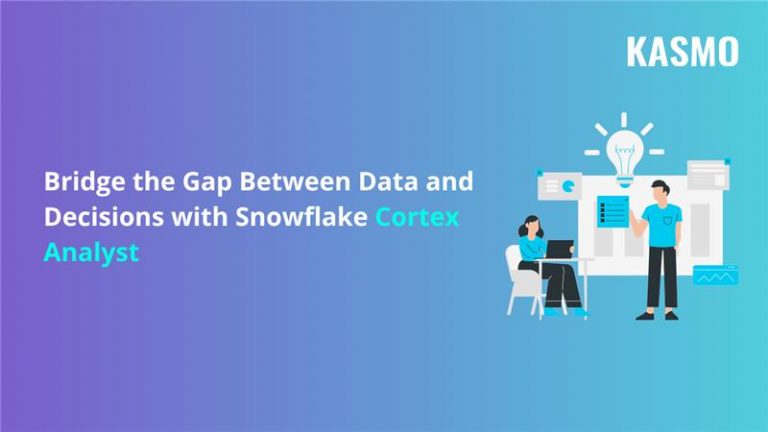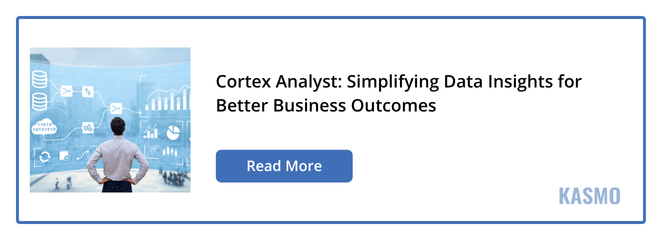Organizations constantly seek smarter, faster, and more efficient ways to extract insights from their information assets. Traditional data analysis often demands technical expertise, slowing down decision-making and limiting access to insights. Snowflake Cortex Analyst enables users to interact with data conversationally, generate instant insights, and make informed decisions without complex SQL queries. It combines large language models (LLMs) with Snowflake’s secure, governed data environment.
In this blog, we explore in detail Snowflake Cortex Analyst, how it works, its use cases in different industries, and best practices to improve its performance for better query responses.
What is Snowflake Cortex Analyst?
Snowflake Cortex Analyst is an advanced, fully managed feature designed to bridge the gap between data and users, regardless of technical expertise. Powered by large language models (LLMs), Cortex Analyst enables users to interact with their data using natural language, allowing them to ask questions in plain English and receive accurate insights almost instantly.
At its core, Cortex Analyst converts text queries into SQL commands automatically, delivering precise results without requiring users to write complex queries. This makes it an ideal solution for organizations looking to empower business users, analysts, or stakeholders having less technical knowledge but need timely access to actionable data.
Key Features of Snowflake Cortex Analyst include
- Cortex Analyst empowers business teams and non-technical users to get instant insights from their structured data using simple, conversational questions. This eliminates the need for complex SQL, enabling faster decision-making and improving data accessibility across the organization.
- Built with an API-first approach, Cortex Analyst can be easily integrated into existing tools like Streamlit, Slack, Teams, or custom chat platforms. This flexibility allows organizations to get data insights directly into the platforms their teams already use, enhancing productivity and collaboration.
- Cortex Analyst uses Snowflake’s intelligent AI service, Cortex, which dynamically selects the most suitable large language models for each query. This ensures that every response is both fast and accurate.
- Unlike generic AI solutions that often misinterpret data structures, Cortex Analyst uses semantic modeling to understand business context and logic. This approach delivers highly accurate text-to-SQL conversions by mapping data relationships and business rules within a YAML-based framework.
- Snowflake’s robust security framework and privacy-centric design help organizations to securely adopt AI, ensuring their data remains protected under stringent governance and compliance standards.
How does Snowflake Cortex Analyst Work?
Snowflake Cortex Analyst uses a multi-step, intelligent process to transform plain-language questions into accurate and SQL-based insights. It also considers strong guardrails to ensure trust and reliability. Here’s a simplified breakdown of how it works:
Request Initiation
The process begins when a user’s question and related data model (in a YAML format) are sent to the Cortex Analyst REST API through an application. This helps to understand and analyze the context of a query to provide a better response.
Question Understanding and Validation
Cortex Analyst first interprets the user’s intent to check if it can provide an accurate answer. If the query is unclear, it suggests similar, answerable questions to keep the user engaged and ensure accuracy. When the question is clear, Cortex uses details from the semantic model to build a complete understanding of the query
Context Enrichment
For questions deemed valid, Cortex Analyst enriches the query using metadata from the YAML file, including details like field names, synonyms, descriptions, and sample data. This helps to provide contextual clarity before generating SQL.
SQL Generation using LLM Agents
Once the context is enriched, multiple large language models (LLMs) collaborate to generate SQL queries. Each LLM is skilled in handling different query complexities. Error correction agent reviews and fixes any syntax or logic issues. This multi-agent approach ensures accuracy and robustness in query generation.
Response and Result Delivery
Finally, a Synthesizer Agent reviews all the SQL outputs and selects the most accurate one to answer the user’s question. The final SQL, along with an interpretation of the query, is sent back to the application. It runs in the background of the client’s application, and results are displayed to the end user.
Use Cases of Snowflake Cortex Analyst Across Industries
Snowflake Cortex Analyst empowers businesses across sectors to get data-driven insights through natural language queries, making analytics accessible to everyone. Here’s how it helps different industries:
Financial Services – Analyze Risks and Performance
In the financial sector, Cortex Analyst helps analysts and advisors quickly explore massive datasets without needing SQL expertise. For example, a financial analyst can ask for information on the 5-year trend in credit card default rates and instantly receive visualized insights. Analysts, advisors, and executives can instantly uncover risk patterns, track investment performance, and monitor compliance metrics without relying on SQL or data engineering expertise.
Healthcare – Insights from Clinical and Patient Data
In healthcare, Cortex Analyst enables clinicians, researchers, and administrators to query complex medical datasets instantly. It helps to easily understand treatment outcomes, analyze patient engagement, and manage costs efficiently without the need for complex SQL queries. It simplifies data exploration across electronic health records (EHRs), claims data, and operational systems, helping organizations improve patient outcomes, monitor resource utilization, and identify trends in disease management.
Retail – Personalized Experiences and Smarter Operations
For retailers, Cortex Analyst transforms raw sales and customer data into actionable insights that boost engagement and profitability. Marketers and merchandisers can use conversational queries to understand product demand, campaign effectiveness, and regional performance. This capability supports inventory optimization and personalized marketing, enabling teams to adapt to changing shopper behavior instantly.
How Cortex Analyst Ensures Data Security and Privacy
Data security and privacy are critical for any enterprise using AI-driven analytics. With Cortex Analyst, organizations can enjoy the benefits of large language models without compromising governance or compliance. It uses metadata from Snowflake environments, like table names, column descriptions, and data types to generate SQL queries. These queries are executed entirely within the Snowflake virtual warehouse, ensuring that sensitive data is never leaked. This design allows enterprises to gain AI-powered insights while maintaining strict data privacy.
Moreover, Cortex Analyst is fully integrated with Snowflake’s security and governance framework. It respects all role-based access control (RBAC) policies, ensuring that users only see data they are authorized to access. By default, queries are processed using Snowflake-hosted LLMs, keeping data within the platform’s governance boundaries. If organizations choose to integrate external AI models, only non-sensitive metadata and user questions are shared to ensure privacy. This combination of LLM capabilities with enterprise-grade security ensures that companies perform AI analytics without risking sensitive information.
How to Improve Cortex Analyst Results in Snowflake?
Optimizing the performance and output quality of Snowflake Cortex Analyst involves careful preparation, configuration, and best practices. Here are five key ways to improve results:

Optimize Your Semantic Models
Cortex Analyst relies on semantic models to understand your data and generate SQL queries. Ensuring these models are accurate and documented is crucial. Start with a smaller, well-defined model for a specific use case, like sales analytics, rather than the entire database. Include clear table and column names, data types, descriptions, and relationships between tables. An effective semantic model helps the LLM understand the data context correctly, resulting in precise and relevant insights.
Use High-Quality Data
The quality of the response is directly influenced by the quality of the data used. Clean, consistent, and up-to-date data reduces errors and misinterpretations by the LLM. Also, use object and row-level security to control data access, which is essential for maintaining data integrity and privacy. Removing duplicates, handling missing values, and maintaining standardized formats for dates, numbers, and categorical data to improve the accuracy of generated SQL queries and ensure reliable outputs.
Contextual Prompts and Questions
The way you phrase questions to the Cortex Analyst also affects results. So, it is essential to use clear, context-rich prompts to specify the desired outcome. Organizations can configure Cortex Analyst to reject ambiguous or unclear questions instead of providing incorrect results. Custom instructions to guide the AI on how to handle certain queries on when to pass them. Providing context enables the LLM to generate more accurate SQL queries and insights tailored to specific business needs.
Use Role-Based Access Control
Cortex Analyst adopts Snowflake’s control policies to ensure secure access. Assign appropriate roles and permissions to users to prevent unauthorized data access while allowing analysts to explore relevant datasets. Use specific commands like SNOWFLAKE.CORTEX_ANALYST_USER to custom roles for control over who can access Cortex Analyst. Correct permissions and access controls help to enhance security and query performance by focusing the LLM on relevant data.
Continuously Monitor and Refine Outputs
Regularly reviewing the outputs generated by Cortex Analyst allows you to identify patterns and errors. It helps you to track which queries deliver accurate insights and which need refinement. Fine-tuning semantic models, updating metadata, and improving prompts will incrementally enhance the system’s performance over time, making the AI insights increasingly reliable and effective.
Conclusion
As organizations strive to make data-driven decisions, the ability to quickly access and interpret information is important. Snowflake Cortex Analyst offers a powerful solution for organizations seeking fast, accurate, and secure access to insights from complex datasets. It helps to analyze complex datasets to provide hidden insights, empowering teams to query data in natural language without needing SQL expertise. Its seamless integration with existing applications and adherence to Snowflake’s privacy-first architecture help businesses to maximize accuracy and deliver better query responses.
Kasmo Snowflake’s expertise helps organizations to effectively implement Cortex Analyst with ongoing support to gain its full potential. Businesses can unify data, automate workflows, and gain real-time, actionable intelligence. Kasmo brings proven expertise in data migration, governance, and AI-powered analytics, ensuring a smooth adoption and measurable business impact.





